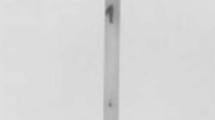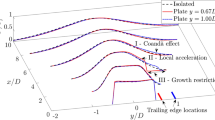Abstract
A new flying hot-wire system has been developed for the measurement of highly turbulent and reversing flows. The apparatus is of rectilinear design, incorporating many features which extend its range of application beyond the range of previous designs. One of the advantages of this system is that it is mounted on a flow visualization wind tunnel which allows complementary qualitative and quantitative studies to be performed. This system has been used successfully to measure turbulent and reversing flows including the flow past a fence. Some results are presented.
Similar content being viewed by others
Abbreviations
- H :
-
height of fence
- LED:
-
light emitting diode
- ST1:
-
Schmitt trigger input signal
- u, v :
-
velocity components in the x and y directions respectively
- 〈u〉, 〈v〉:
-
phase-averaged components of u and v
- x, y :
-
orthogonal coordinate system with the x-direction aligned with the centreline along the tunnel floor and the y-component normal to the floor
References
Cantwell, B.; Coles, D. 1983: An experimental study of entrainment and transport in the turbulent near wake of a circular cylinder. J. Fluid Mech. 136, 321–374.
Kelso, R. M.; Lim, T. T.; Perry, A. E. 1993: A novel flying hot-wire system. Report No. FM-21, University of Melbourne.
Perry, A. E. 1982: Hot-wire anemometry, Clarendon Press, Oxford.
Perry, A. E.; Lim, K. L.; Henbest, S. M.; Chong, M. S. 1983: Roughand smooth-walled shear flows. Proc 5th International Symposium on Turbulent Shear Flow, Cornell U.S.A..
Perry, A. E.; Morrison, G. L. 1971: Static and dynamic calibration of constant-temperature hot-wire systems. J. Fluid Mech. 47, 765–777.
Perry, A. E.; Steiner, T. R. 1987: Large-scale vortex structures in turbulent wakes behind bluff bodies. Part 1. Vortex formation processes. J. Fluid Mech. 174, 233–270.
Perry, A. E.; Tan, D. K. 1984: Simple three-dimensional vortex motions in coflowing jets and wakes. J. Fluid Mech. 141, 197–231.
Perry, A. E.; Watmuff J. H. 1981: The phase-averaged large-scale structures in three-dimensional turbulent wakes. J. Fluid Mech. 103, 33–51.
Thompson B. E.; Whitelaw, J. H. 1984: Flying hot-wire anemometry. Exp. Fluids 2, 47–55.
Watmuff, J. H. 1979: Phase-averaged large-scale structures in three-dimensional turbulent wakes. Ph.D. Thesis, University of Melbourne.
Watmuff, J. H.; Perry, A. E.; Chong, M. S. 1983: A flying hot-wire system. Exp. Fluids 1, 63–71.
Author information
Authors and Affiliations
Rights and permissions
About this article
Cite this article
Kelso, R.M., Lim, T.T. & Perry, A.E. A novel flying hot-wire system. Experiments in Fluids 16, 181–186 (1994). https://doi.org/10.1007/BF00206537
Received:
Accepted:
Issue Date:
DOI: https://doi.org/10.1007/BF00206537




